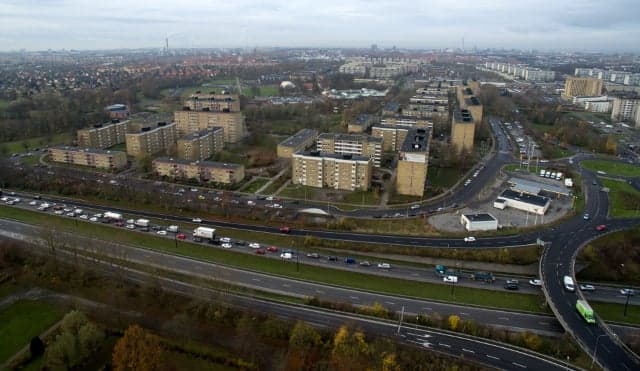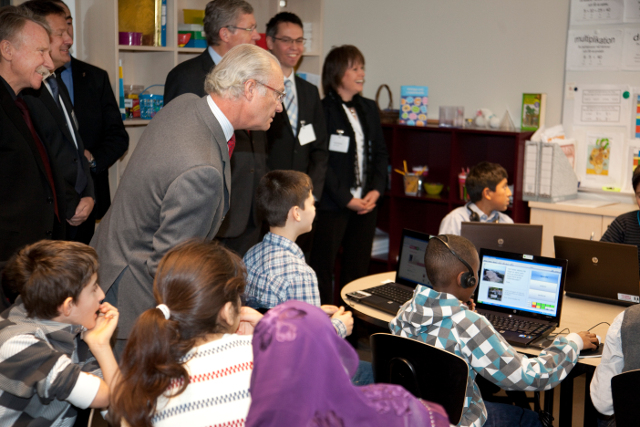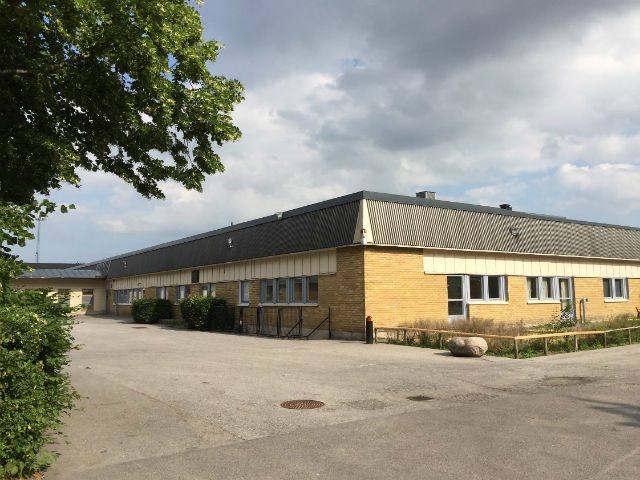How Malmö turned around some of its worst schools

When Malmö's Örtagårdsskolan was built in 1970, the idea was that it would draw pupils both from the newly built Rosengård district to the north, and from the middle-class area of detached houses to the south.
This article is available to Members of The Local. Read more articles for Members here.
But over the last 20 years, people in the area of detached houses, called Gamla Rosengård or Västra Kattarp, turned their backs on the school.
Now thanks to a remarkable turnaround at what was one of Malmö's most troubled schools, the first group of pupils in years has come from the area.
Lina Cagérus Barucija, a psychologist, is a parent of one of the six children from Gamla Rosengård who this year are going to the school. As well as the location, just a ten-minute walk from her house, Cagérus Barucija was attracted by the investment Malmö has made in improving standards and the fact that it has a library with its own librarian.
"It's not too big a school and they have had a lot of resources for a long time now," she explained. "Most schools have only one or two förstelärare [an elite grade of teacher], they have ten. That's a big difference."
The Malmö artist Ellisif Hals, who also sent her son to the school this year, said that an important factor had been that a group of parents in the neighbourhood had clubbed together, first coordinating over Facebook, then visiting the school together.
"It helped, absolutely. Just the feeling of having a community around you," she said of the parents in Gamla Rosengård. "There was one family that was very decided that they were going to send the child to Örtagårdsskolan. Then there was this group that crystallized over a few years."
She said she had also been impressed by the school's openness, with pupils making a monthly TV news show about what goes on there.
To each according to their need
Örtagårdsskolan's turn-around is part of a wider story, which has also seen major improvements at other schools such as Stenkulaskolan, and Sofielundsskolan.
In 2011, Malmö's elementary schools, which cater to children between six and 16 years old, were among the worst in Sweden, coming 270th out of the country's 290 municipalities according to the annual ranking by The Swedish Association of Local Authorities and Regions. In 2017, the city came 171st.
"We have climbed 100 steps," said Anders Malmquist, director of of the city's elementary schools. "All of us who work in schools in Malmö, we are very proud that we've actually made a difference and that the results are a lot better."
"Pupils are doing better in most of our schools in our underprivileged areas, and behind that is a lot of work."

Sweden's King Carl XVI Gustaf visiting Sofielundsskolan in 2011. Photo: Stig-Åke Jönsson/TT
Key to the improvement was the decision five years ago to take management of schools away from all the city's districts and centralize them in three municipal school organizations, one for elementary schools, one for upper secondary, and one for free schools.
Malmquist, who was given command of the elementary schools, decided to concentrate funding in those schools which faced the biggest challenges, both in terms of the large number of native languages spoken by pupils at home and the educational level and economic status of their parents.
"We made it so that how much money you get depends on what kind of pupils you have in a school," he explain. "So for example, if you go to Rosengårdsskolan, which is one of the poorest schools, and you compare it to Djupadalsskolan, which is one of the richest, a 10-year-old pupil will get almost twice as much money."
While Malmö hasn't halved class sizes in poor schools, as is happening in France under President Emmanuel Macron, it is not far off. At Örtagårdsskolan, there are 11.4 pupils per teacher, compared to 17 at Djupadalsskolan.
Malmquist said the city had in particular studied the example of Canada, where many schools also have a high proportion of immigrants, leaning heavily on the research of the Canadian educationalist Michael Fullan, who sees encouraging teachers to reflect on their work and learn from one another as the key to turning around schools.
New faces
According to Ewalotta Benndoff, Örtagårdsskolan's deputy headmaster, the five pupils are the first group to come from the area of detached houses for many years.
"This is new," she said. "What happened was that in the spring, the parents of these children contacted us and said they wanted to come, and I met them and told them about the school."
Cagérus Barucija said that her neighbour in Gamla Rosengård had sent her three sons to the school in the 1990s.
But then the free school reforms Sweden brought in in 1992 started to increase segregation in the city's schools, and particularly at Örtagårdsskolan, with the very clearly defined border between the Gamla Rosengård and the Million Homes project meaning many parents didn't identify with the area.
In recent years, parents with school-age children in Gamla Rosengård have either sent their children to free schools such as the popular Kastanjeskolan or to municipal schools further afield. And Cagérus Barucija does not want to blame her predecessors for doing so.
"The reason that this hasn't happened earlier is that it wasn't so long ago that Örtagårdsskolan was extremely chaotic," she said. "It has only become stable in the last four or five years."
Eight years ago, teachers were being threatened by pupils' families, and a six-year-old pupil walked out of the school without staff noticing, only to be found, lost and panicking by her father on the streets.

Malmö's Örtagårdsskolan. Photo: Malmö City Council
Even today, Cagérus Barucija admitted, she would not have sent her child to some other schools which still face problems. According to an investigation this year by the Sydsvenskan newspaper, Värner Rydén and Rosengårdsskolan still face problems, with the organization Fryshuset now in discussions over taking control of the former school with the Centre Party.
Hals said that her decision had not primarily been political.
"You don't make a political choice with your children's school. No one does that. We're not activists. We just did what we thought was best for our children, as we saw it."
Rather than other children in the neighbourhood spread out at schools across the city, as has happened before, her children will benefit from having friends who attend a school less than ten minutes' walk away, she said.
"You want to give your children a neighbourhood, a place where they feel they come from. It's worth so much. That was top of the list."
But she admitted that she had also been inspired by parents in her native Norway who grouped together to send their children to the heavily segregated Tøyen Skole in the centre of Oslo, reversing a process of 'white flight'.
"Everyone [ethnic Norwegian] was moving away from this school, and then they started this neighbourhood group, and made a radio documentary about this family, and turned it around. I think it's worked well."
A place of arrival
Malmquist said that Malmö's continuing appeal as a place to live for immigrants newly arrived in Sweden meant that the city's schools could never compete with the country's top municipalities in terms of improving its results in the league tables.
"We know that we will continue climbing, but as long as we have these huge amounts of immigrants coming to Malmö, we will not be able to be top 50."
Rosengård is particularly affected by a high turnover of new arrivals and their children – many of them with no prior knowledge of Swedish – with many moving elsewhere once they are established in Sweden, speak the language, have become used to the school system and have a chance at improving their test scores.
As The Local reported earlier this year, a 2017 report showed that the performance gap between foreign-born students and native students had increased significantly in Sweden – but almost the entire gap disappeared when socioeconomic background and neighbourhood were taken into consideration.
This year, Malmquist pointed out, Malmö's elementary schools took in more recently arrived immigrant pupils than it had done even during the peak of the refugee wave of 2015 and 2016, as the children of families who had been placed in other parts of Sweden moved to the city.
"In Rosengård, they study and get work, and then they move to other parts of the city. And what then happens? You get new immigrants," he said.
This means that the cycle of segregation continues, unless some families are willing to take the first step.
Getting rooted
So far, both the Gamla Rosengård couples' children are enjoying Örtagårdsskolan school and making friends, and the parents have been impressed both with the teachers and with the other parents at the school.
"I thought there would be fewer parents coming to meetings than in another schools, that they wouldn't have the time and energy to engage," Cagérus Barucija said. "But all the parents were there."
She has discovered that as many as 80 percent of the parents at the school made an active choice to send their children there (rather than automatically being enrolled based on geographical proximity), indicating that it draws the children of the most informed and involved parents in Rosengård.
All in all, Hals has been pleased with what's she's seen. "It's not so easy to say after such a short time," she said. "But I have a good impression, and also from him [her son], that it's good."
She said she hoped that their example would encourage others to do the same, as happened at Tøyen Skole.
"There are really good possibilities for the future, because there are more and more young families moving to this area. If this is rooted, it could be really great."
Comments
See Also

Sweden's King Carl XVI Gustaf visiting Sofielundsskolan in 2011. Photo: Stig-Åke Jönsson/TT

Malmö's Örtagårdsskolan. Photo: Malmö City Council
Malmquist said that Malmö's continuing appeal as a place to live for immigrants newly arrived in Sweden meant that the city's schools could never compete with the country's top municipalities in terms of improving its results in the league tables.
"We know that we will continue climbing, but as long as we have these huge amounts of immigrants coming to Malmö, we will not be able to be top 50."
Rosengård is particularly affected by a high turnover of new arrivals and their children – many of them with no prior knowledge of Swedish – with many moving elsewhere once they are established in Sweden, speak the language, have become used to the school system and have a chance at improving their test scores.
As The Local reported earlier this year, a 2017 report showed that the performance gap between foreign-born students and native students had increased significantly in Sweden – but almost the entire gap disappeared when socioeconomic background and neighbourhood were taken into consideration.
This year, Malmquist pointed out, Malmö's elementary schools took in more recently arrived immigrant pupils than it had done even during the peak of the refugee wave of 2015 and 2016, as the children of families who had been placed in other parts of Sweden moved to the city.
"In Rosengård, they study and get work, and then they move to other parts of the city. And what then happens? You get new immigrants," he said.
This means that the cycle of segregation continues, unless some families are willing to take the first step.
Join the conversation in our comments section below. Share your own views and experience and if you have a question or suggestion for our journalists then email us at [email protected].
Please keep comments civil, constructive and on topic – and make sure to read our terms of use before getting involved.
Please log in here to leave a comment.